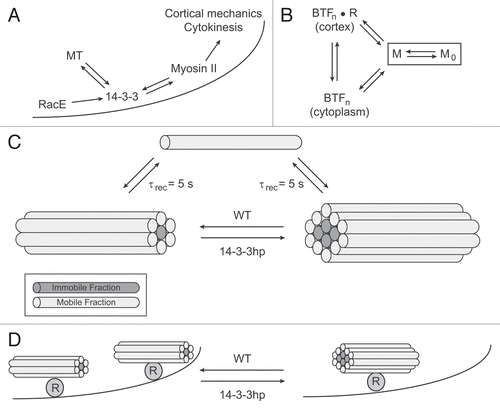Figures & data
Figure 1 14-3-3 coordinates RacE, microtubules and myosin II. (A) A pathway diagram demonstrating how 14-3-3 operates downstream of RacE and microtubules (MT) but is required to maintain MT length. 14-3-3 also promotes myosin II bipolar thick filament (BTF) remodeling along the cortex (depicted by the curved line) in order to modulate cortical mechanics and cytokinesis shape change. (B) Myosin II BTF assembly occurs through a nucleation-elongation process.Citation43 The assembly incompetent form of myosin II (M0) is maintained by heavy chain phosphorylation. The assembly competent form (M) can nucleate BTFs with n monomers per BTF. These can be formed in the cytoplasm or on the cortex. Some evidence suggests that cortex anchoring may occur through some receptor R that binds to the coiled coils of the BTFs.Citation44,Citation45 (C) Alterations in 14-3-3 expression levels do not affect the recovery time (τrec = 5 s) measured by FRAP. However, the immobile fraction is increased by 14-3-3 depletion using a 14-3-3 RNAi hairpin vector (14-3-3 hp). One way to achieve this is if the myosin monomers M (depicted as rods with motor domains not shown) are able to release with similar kinetics, but if 14-3-3 helps maintain smaller BTFs (which are predicted to be exponentially distributed by sizeCitation46), then fewer monomers will be buried deep within the BTF (BTFs assemble through lateral interactions so that the BTF primarily grows by increasing in diameter rather than length). (D) 14-3-3 (along with RacE) might also form part of a cortical receptor complex (R). If the cortical receptors also help nucleate the BTFs, fewer receptors (for example by depleting 14-3-3 with 14-3-3 hp) would lead to fewer nucleation centers. This might then increase the immobile fraction as depicted in (C).
